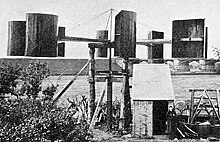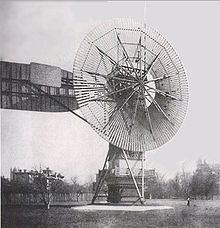History
Main article: History of wind power
James Blyth's electricity generating wind turbine photographed in 1891
Windmills were used in Persia (present-day Iran) as early as 200 B.C.
[1] The windwheel of Heron of Alexandria marks one of the first known instances of wind powering a machine in history.
[2][3] However, the first known practical windmills were built in Sistan, a region between Afghanistan and Iran, from the 7th century. These "Panemone" were vertical axle windmills, which had long vertical driveshafts with rectangular blades.
[4] Made of six to twelve sails covered in reed matting or cloth material, these windmills were used to grind grain or draw up water, and were used in the gristmilling and sugarcane industries.
[5]
Windmills first appeared in Europe during the middle ages. The first historical records for their use in England date to the 11th or 12th centuries and there are reports of German crusaders taking their windmill-making skills to Syria around 1190.
[6] By the 14th century, Dutch windmills were in use to drain areas of the Rhine delta.
The first automatically operated wind turbine, built in Cleveland in 1887 by Charles F. Brush. It was 60 feet (18 m) tall, weighed 4 tons (3.6 metric tonnes) and powered a 12kW generator.
[7] The first electricity generating wind turbine, was a battery charging machine installed in July 1887 by Scottish academic James Blyth to light his holiday home in Marykirk, Scotland.
[8] Some months later American inventor Charles F Brush built the first automatically operated wind turbine for electricity production in Cleveland, Ohio.
[8] Although Blyth's turbine was considered uneconomical in the United Kingdom
[8] electricity generation by wind turbines was more cost effective in countries with widely scattered populations.
[6] In Denmark by 1900, there were about 2500 windmills for mechanical loads such as pumps and mills, producing an estimated combined peak power of about 30 MW. The largest machines were on 24-metre (79 ft) towers with four-bladed 23-metre (75 ft) diameter rotors. By 1908 there were 72 wind-driven electric generators operating in the US from 5 kW to 25 kW. Around the time of World War I, American windmill makers were producing 100,000 farm windmills each year, mostly for water-pumping.
[9] By the 1930s, windmills for electricity were common on farms, mostly in the United States where distribution systems had not yet been installed. In this period, high-tensile steel was cheap, and windmills were placed atop prefabricated open steel lattice towers.
A forerunner of modern horizontal-axis wind generators was in service at Yalta, USSR in 1931. This was a 100 kW generator on a 30-metre (98 ft) tower, connected to the local 6.3 kV distribution system. It was reported to have an annual capacity factor of 32 per cent, not much different from current wind machines.
[10] In the fall of 1941, the first megawatt-class wind turbine was synchronized to a utility grid in Vermont. The Smith-Putnam wind turbine only ran for 1,100 hours before suffering a critical failure. The unit was not repaired because of shortage of materials during the war.


No comments:
Post a Comment